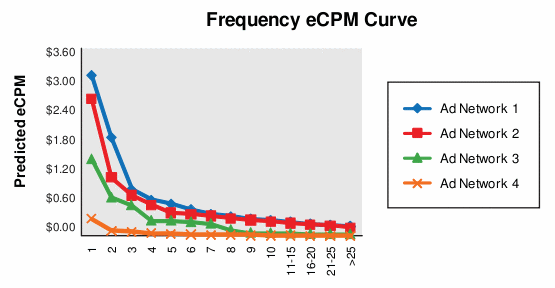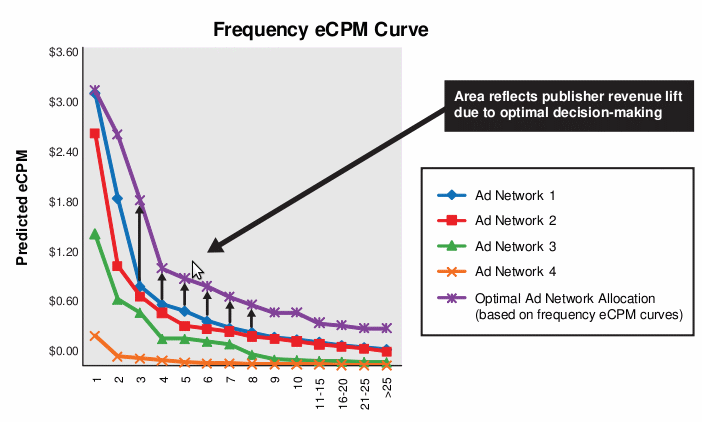Online Advertising Management: Frequency Capping To Optimize Ad Revenues
Frequency capping has long been used as a method for helping advertisers to improve the performance and reach of their online advertising campaigns.

Photo credit: Cier
In short, frequency capping allows the advertiser to limit the number of times a user sees a specific ad, resulting in increased return to the advertiser for every dollar spent.
While the benefits of frequency capping for advertisers are clear, frequency capping can result in significant challenges for publishers.
In particular, for advertising campaigns run by ad networks on a publisher's web site, frequency capping can result in significant revenue loss for publishers.
Publishers have very limited insight into ad network pricing and are unable to determine how to allocate inventory to ad networks based on particular frequencies.
This white paper describes current trends in online advertising, the challenges publishers face with respect to managing their ad inventory, the components of a solution that take into account the relationship between frequency and eCPM in ad serving decisions, and PubMatic's frequency revenue optimization solution.
Predicting Ad Network Frequency Capping To Increase Publisher Revenue

by PubMatic
Market Trends Are Expediting a Shift To Performance Advertising

Marketers' success metrics are defined by the advertiser or media agency, and vary with respect to how they are measured. However, today's economic climate has created a need for advertisers to demand more campaign accountability with less monetary investment, or greater ROI.
This has helped to expedite an already growing trend: advertisers are moving away from pure branding campaigns where the success metrics can be very subjective, and more towards performance based campaigns where success metrics are more clearly defined.
Economics are not the only reason why performance based advertising is a quickly growing trend; technological advancements have made it possible for advertisers to closely monitor and measure a more granular level of performance metrics of an advertising campaign.
Advertisers are taking advantage of these technology advancements to get better control over where, when, and to whom their ads are being displayed.
Traditional Role of Frequency In Online Advertising

One of the ways that advertisers are achieving enhanced performance from their online advertising campaigns is through the use of frequency capping.
The term "frequency capping" refers to restricting (capping) the amount of times (frequency) a specific visitor is shown a particular advertisement within a period of time.
For example, a frequency cap of "3 per 24" for an ad means that after exposing the user to the same ad 3 times, the visitor will not be shown that ad for 24 hours.
Some of the key benefits of frequency capping are:
- Increased reach - frequency capping is an efficient way to increase reach by expanding the number of unique users that see the ad.
Rather than using a marketer's scarce budget to show the same ad to a small number of users over and over again, frequency capping can be used to ensure that a wider audience is exposed to the marketer's message.
- Increased CTR - frequency is used as one of the key drivers to improve advertising campaign performance.
Click Through Rates (CTR) have been shown to drop precipitously after the first exposure and to plateau at four because of "ad blindness", wherein the user becomes so used to seeing the ad that the user essentially becomes blind to that ad.
- Improved conversation rates - similar to CTR, the conversion rates also are highest on the first impression and typically diminish after 4 - 6 impressions.
Decoding The Frequency - eCPM Relationship With Ad Networks

Actual frequency eCPM curves for different ad networks based on actual eCPM data collected by PubMatic for a client publisher on a particular day
Ad networks generally have multiple campaigns running at any given time, and those campaigns have different frequency cap, pricing and other characteristics, as specified by the advertiser.
Based on the success metrics defined by the advertiser and expected performance of the campaigns, ad networks value the first impression a user sees more than their second impression, and so forth.
Ad networks then allocate the highest paying campaigns to the first user impression, followed by the next highest paying ad campaign and so on.
While ad networks have their campaign delivery structured in a way that will maximize their performance metrics, the ad networks' data is not made transparent to the publisher in a way that allows the publisher to maximize their revenue.
Without access to ad network pricing, it impossible for publishers to allocate their inventory in the best way possible. As a result, publishers require a solution that gives them insight into ad network pricing so that publishers can maximize the value of each impression shown on their web sites.
In order for publishers to maximize revenue on every impression, there first needs to be a method to predict where the most valuable impressions are coming from, and when.
The best method for achieving this is collecting historical data in order to find the relationship between frequency and eCPMs, and then creating a frequency eCPM curve.
A frequency eCPM curve is created by averaging eCPM data across thousands or millions of users on a site. Such a curve reflects the average eCPM that can be expected at different user frequencies from a particular ad network.
Optimal Impression Allocation Based On Ad Networks Frequency eCPM Curves

Given these frequency eCPM curves it is evident that in order to maximize the revenue for the publisher, an optimal impression allocation strategy across all of its ad networks can be set up as shown in the graph below.
For example, instead of giving all impressions to Ad Network -1 first, the publisher would allocate the first impression to Ad Network -1, the second impression to Ad Network -2, and the third impression to Ad Network -1 again and so forth as is detailed in the table below.
Implementing Optimal Frequency-Based Decision Making: Frequency Revenue Optimization

The data that is collected and applied to the frequency eCPM curve can be used for predictive modeling. However, leveraging this data to maximize the revenue of every single impression requires real-time decision making, and that is impossible to do without the assistance of advanced technology.
Understanding this, PubMatic has developed a propriety solution called frequency revenue optimization.
How frequency revenue optimization works:
- Frequency eCPM curve predictions - By observing the frequency impression distribution, default impression distribution, and eCPM trends from an ad network on a continuous basis, an overall frequency eCPM curve for each ad network can be predicted.
- Dynamic impressions allocation to ad networks using Frequency eCPM curves - Each impression can then be optimally allocated to the ad network with the highest expected frequency eCPM, maximizing overall revenue.
Benefits To Implementing Frequency Revenue Optimization

- Increased revenue for publishers - by intelligently allocating ad impressions across a mix of ad networks, based on the frequency - eCPM relationship, publishers can generate significantly higher revenue for each ad impression.
- Reduced number of defaults - default rates for ad networks can be reduced significantly by allocating impressions to the best monetization opportunity. This results in reduced ad serving costs for publishers and ad networks as well as a better user experience because of faster web page load times.
- Better user experience - frequency revenue optimization improves the user experience significantly by showing different and more relevant ads to a user during a web session. This is reflected in higher CTR rates on ads.
- Higher quality traffic to ad networks - ad networks win with frequency revenue optimization because the web sites in their network perform better. The reduction in ad blindness and higher click-through rates translate into better performance for advertisers.
Examples of Publishers That Have Used Frequency Revenue Optimization

Benefits derived from frequency revenue optimization vary from site to site. There are several examples of publishers of varying sizes and verticals that have enjoyed demonstrated success with PubMatic's Dynamic Default Optimization.
Conclusion
The major challenge presented to publishers with frequency capped campaigns is allocating inventory to ad networks in a way that will maximize publisher revenue. What makes this a challenge is the lack of transparency from ad networks about pricing, which makes it impossible for publishers to allocate their inventory in the best way possible. As a result, publishers leave substantial money on the table.
Originally written by the PubMatic team and first published on June 1st 2009 as "Predicting Ad Network Frequency Capping to Increase Publisher Revenue".
Disclosure: Pubmatic has no commercial or advertising relationships with MasterNewMedia. This white paper has been republished in its integrity for the value that it provides to professional web publishers and online advertisers in general. Specific paragraphs inside this white paper that provided direct reference to Pubmatic and its frequency capping services have been moved out of the main content and are published here below.
About the author
![]()
Founded in 2006, PubMatic is an ad revenue optimization service that helps web site publishers run the highest paying ads from top ad networks.
Frequency revenue optimization is a solution that PubMatic has developed as a way to give publishers the insight they need in order to implement an optimal inventory allocation strategy for frequency capped campaigns.
Over the last 8 months, PubMatic has developed a proprietary frequency revenue optimization solution that maps the relationship between frequency and eCPM for a particular ad network and optimizes ad serving decisions in real time.
This solution has been deployed to over 100 large publisher web sites, resulting in the following benefits for publishers:
- Up to 35% increase in eCPM
- 50% to 210% increase in CTR (click-through rate)
- 10% to 50% decrease in ad network defaults (ad requests for which the ad network has no ad to show)
In addition to the significant publisher benefits, frequency revenue optimization has also increased the flow of desired traffic to ad networks, reduced their ad serving costs by decreasing their default rates, and enhanced the end user experience by loading more relevant ads faster.
To date, over 100 premier publishers have successfully leveraged this solution to increase their revenue.
Photo credits:
Increasing Revenue For Publishers and Ad Networks With Frequency Revenue Optimization - Gabriel Moisa
Market Trends Are Expediting A Shift To Performance Advertising - juliengron
Traditional Role of Frequency In Online Advertising - Pavel Muron
Implementing Optimal Frequency-Based Decision Making: Frequency Revenue Optimization - Bruce Parrott
Benefits To Implementing Frequency Revenue Optimization - Micrologo
Examples of Publishers That Have Used Frequency Revenue Optimization - Cathy Yeulet
Reference: PubMatic [ Read more ]

blog comments powered by Disqus